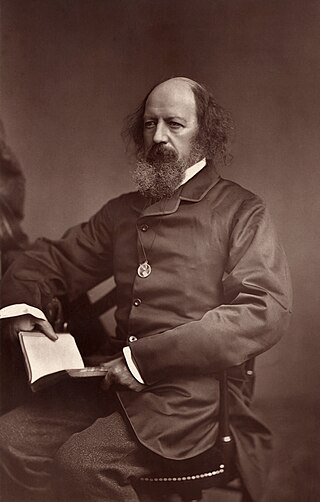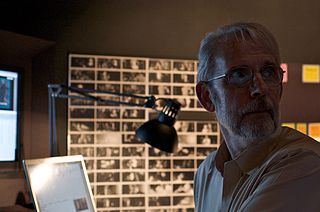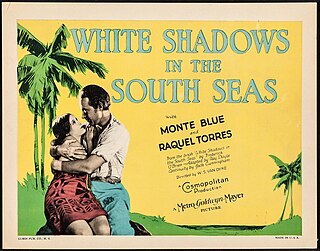Related Research Articles

Back to the Future is a 1985 American science fiction film directed by Robert Zemeckis and written by Zemeckis and Bob Gale. It stars Michael J. Fox, Christopher Lloyd, Lea Thompson, Crispin Glover, and Thomas F. Wilson. Set in 1985, it follows Marty McFly (Fox), a teenager accidentally sent back to 1955 in a time-traveling DeLorean automobile built by his eccentric scientist friend Emmett "Doc" Brown (Lloyd), where he inadvertently prevents his future parents from falling in love – threatening his own existence – and is forced to reconcile them and somehow get back to the future.

Alfred Tennyson, 1st Baron Tennyson was an English poet. He was the Poet Laureate during much of Queen Victoria's reign. In 1829, Tennyson was awarded the Chancellor's Gold Medal at Cambridge for one of his first pieces, "Timbuktu". He published his first solo collection of poems, Poems, Chiefly Lyrical, in 1830. "Claribel" and "Mariana", which remain some of Tennyson's most celebrated poems, were included in this volume. Although described by some critics as overly sentimental, his verse soon proved popular and brought Tennyson to the attention of well-known writers of the day, including Samuel Taylor Coleridge. Tennyson's early poetry, with its medievalism and powerful visual imagery, was a major influence on the Pre-Raphaelite Brotherhood.
The Academy Award for Best Picture is one of the Academy Awards presented annually by the Academy of Motion Picture Arts and Sciences (AMPAS) since the awards debuted in 1929. This award goes to the producers of the film and is the only category in which every member of the Academy is eligible to submit a nomination and vote on the final ballot. The Best Picture category is traditionally the final award of the night and is widely considered as the most prestigious honor of the ceremony.

Robert Lee Zemeckis is an American film director, producer, and screenwriter. He first came to public attention as the director of the action-adventure romantic comedy Romancing the Stone (1984), the science-fiction comedy Back to the Future trilogy (1985–1990), and the live-action/animated comedy Who Framed Roger Rabbit (1988). He subsequently directed the satirical black comedy Death Becomes Her (1992) and then diversified into more dramatic fare, including Forrest Gump (1994), for which he won the Academy Award for Best Director. The film also won the Best Picture.

Back to the Future Part II is a 1989 American science fiction film directed by Robert Zemeckis from a screenplay by Bob Gale; both wrote the story. It is the sequel to the 1985 film Back to the Future and the second installment in the Back to the Future franchise. The film stars Michael J. Fox, Christopher Lloyd, Lea Thompson, and Thomas F. Wilson with Elisabeth Shue, and Jeffrey Weissman in supporting roles. It follows Marty McFly (Fox) and his friend Dr. Emmett "Doc" Brown (Lloyd) as they travel from 1985 to 2015 to prevent Marty's son from sabotaging the McFly family's future. When their arch-nemesis Biff Tannen (Wilson) steals Doc's DeLorean time machine and uses it to alter history for his benefit, the duo must return to 1955 to restore the timeline.
Alfred, Lord Tennyson, the first Baron Tennyson, was an English poet.

Walter Scott Murch is an American film editor, director, writer and sound designer. His work includes THX 1138, Apocalypse Now, The Godfather I, II, and III, American Graffiti, The Conversation, Ghost and The English Patient, with three Academy Award wins.

The Charge of the Light Brigade is a 1936 American historical adventure film from Warner Bros., starring Errol Flynn and Olivia de Havilland. It was directed by Michael Curtiz and produced by Samuel Bischoff, with Hal B. Wallis as the executive producer. The film's screenplay is by Michael Jacoby and Rowland Leigh, from a story by Michael Jacoby, and based on the 1854 poem "The Charge of the Light Brigade" by Alfred, Lord Tennyson. The music score was composed by Max Steiner, his first for Warner Bros., and the cinematography was by Sol Polito. Scenes were shot at the following California locations: Lone Pine, Sherwood Lake, Lasky Mesa, Chatsworth, and Sonora. The Sierra Nevada mountains were used for the Khyber Pass scenes.

Ben 10: Race Against Time is a 2007 American superhero film based on the animated television series Ben 10, created by Man of Action.

White Shadows in the South Seas is a 1928 American synchronized sound film adventure romance directed by W.S. Van Dyke and starring Monte Blue and Raquel Torres. It was produced by Cosmopolitan Productions in association with MGM and distributed by MGM. While the film has no audible dialog, it was released with a synchronized musical score with sound effects using the sound-on-film Western Electric Sound System process. Loosely based on the travel book of the same name by Frederick O'Brien. This film is important historically for being the first sound MGM film to be released as it featured a pre-recorded soundtrack. Clyde De Vinna won an Academy Award for Best Cinematography.
Harold William Varney was an American motion picture sound mixer. A two-time Academy Award winner, Varney shared the Academy Award for Best Sound Mixing for Star Wars: Episode V - The Empire Strikes Back in 1980 and Raiders of the Lost Ark in 1981. Varney also received Academy Award for Best Sound Mixing nominations for his collaborative sound mixing on Dune in 1984 and Back to the Future in 1985.
William B. Kaplan is an American sound engineer. He has over 125 credits to his name and has been nominated for seven Academy Awards in the category Best Sound. He has worked on over 80 films since 1972.
Alan Howarth is an American composer and sound designer who has worked on soundtracks for Hollywood films including the Star Trek and Halloween series, and is known for his collaborations with film director and composer John Carpenter.
Matthew Tennyson is an English actor of stage and screen. He won the Evening Standard Award for Outstanding Newcomer in 2012.
Charles L. Campbell was an American sound engineer who won three Academy Awards for Best Sound Editing. He also served as Governor of the Academy of Motion Picture Arts and Sciences (AMPAS) 1984-1987.
Robert Rutledge was an American sound editor who won Best Sound Editing at the 1985 Academy Awards. He won for Back to the Future, which was shared with Charles L. Campbell.
Louis Edemann was an American sound editor. He won the Academy Award for Best Sound Editing during the 61st Academy Awards. He won for the film Who Framed Roger Rabbit, he shared his Oscar with Charles L. Campbell.
Kenneth F. Smith is a special effects artist. He works at ILM as well. He also won 2 Academy awards.
Steve Gawley is a visual effects artist who was nominated at the 62nd Academy Awards in the category of Best Visual effects for his work on the film Back to the Future Part II. His nomination was shared with John Bell, Michael Lantieri and Ken Ralston.
John Bell is a special effects artist who was nominated at the 62nd Academy Awards in the category of Best Visual effects for his work on the film Back to the Future Part II. His nomination was shared with Steve Gawley, Michael Lantieri and Ken Ralston.
References
- ↑ "The 58th Academy Awards (1986) Nominees and Winners". oscars.org. Retrieved October 16, 2011.